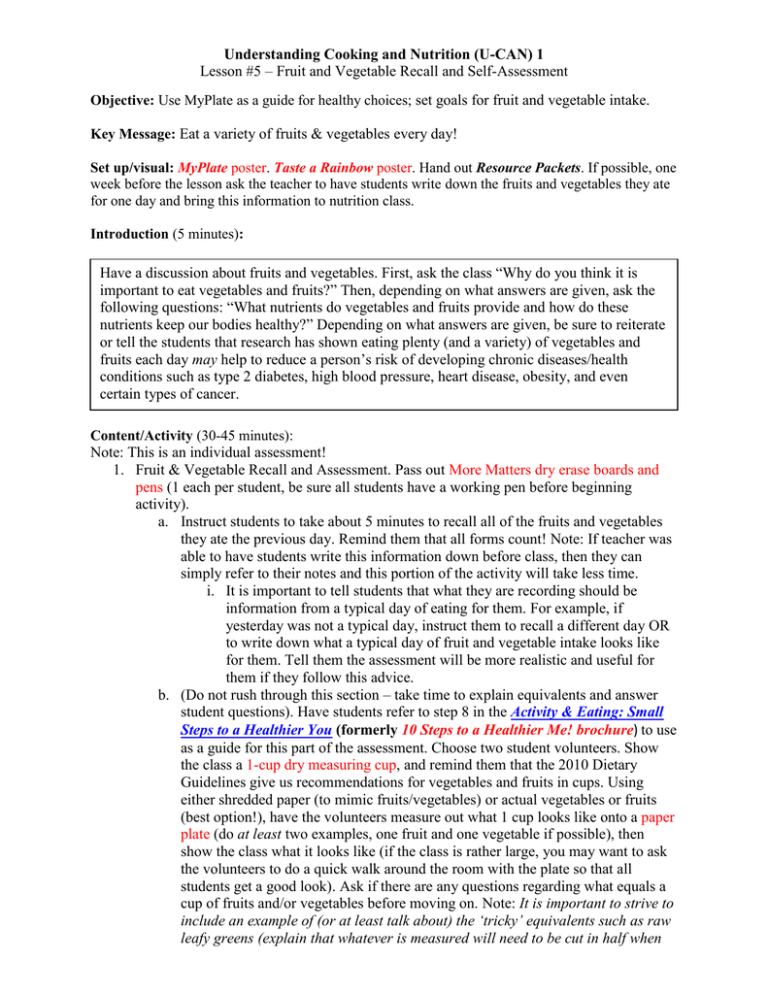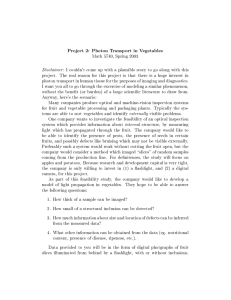Lesson 5 - Fruit Veggie Recall and Self-Assessment Lesson Plan
advertisement

Understanding Cooking and Nutrition (U-CAN) 1 Lesson #5 – Fruit and Vegetable Recall and Self-Assessment Objective: Use MyPlate as a guide for healthy choices; set goals for fruit and vegetable intake. Key Message: Eat a variety of fruits & vegetables every day! Set up/visual: MyPlate poster. Taste a Rainbow poster. Hand out Resource Packets. If possible, one week before the lesson ask the teacher to have students write down the fruits and vegetables they ate for one day and bring this information to nutrition class. Introduction (5 minutes): Have a discussion about fruits and vegetables. First, ask the class “Why do you think it is important to eat vegetables and fruits?” Then, depending on what answers are given, ask the following questions: “What nutrients do vegetables and fruits provide and how do these nutrients keep our bodies healthy?” Depending on what answers are given, be sure to reiterate or tell the students that research has shown eating plenty (and a variety) of vegetables and fruits each day may help to reduce a person’s risk of developing chronic diseases/health conditions such as type 2 diabetes, high blood pressure, heart disease, obesity, and even certain types of cancer. Content/Activity (30-45 minutes): Note: This is an individual assessment! 1. Fruit & Vegetable Recall and Assessment. Pass out More Matters dry erase boards and pens (1 each per student, be sure all students have a working pen before beginning activity). a. Instruct students to take about 5 minutes to recall all of the fruits and vegetables they ate the previous day. Remind them that all forms count! Note: If teacher was able to have students write this information down before class, then they can simply refer to their notes and this portion of the activity will take less time. i. It is important to tell students that what they are recording should be information from a typical day of eating for them. For example, if yesterday was not a typical day, instruct them to recall a different day OR to write down what a typical day of fruit and vegetable intake looks like for them. Tell them the assessment will be more realistic and useful for them if they follow this advice. b. (Do not rush through this section – take time to explain equivalents and answer student questions). Have students refer to step 8 in the Activity & Eating: Small Steps to a Healthier You (formerly 10 Steps to a Healthier Me! brochure) to use as a guide for this part of the assessment. Choose two student volunteers. Show the class a 1-cup dry measuring cup, and remind them that the 2010 Dietary Guidelines give us recommendations for vegetables and fruits in cups. Using either shredded paper (to mimic fruits/vegetables) or actual vegetables or fruits (best option!), have the volunteers measure out what 1 cup looks like onto a paper plate (do at least two examples, one fruit and one vegetable if possible), then show the class what it looks like (if the class is rather large, you may want to ask the volunteers to do a quick walk around the room with the plate so that all students get a good look). Ask if there are any questions regarding what equals a cup of fruits and/or vegetables before moving on. Note: It is important to strive to include an example of (or at least talk about) the ‘tricky’ equivalents such as raw leafy greens (explain that whatever is measured will need to be cut in half when they record their intake amount) and dried fruit (explain that whatever is measured will need to be doubled when they record their intake amount), so they students can be sure to estimate their intake amounts as accurately as possible for a more meaningful assessment. c. Instruct students to estimate how many cups they ate of each fruit or vegetable they have listed, then have them total the amounts of each in 1 cup equivalents. d. Referencing the Catch a Rainbow Every Day poster, remind the students that it is important not only to get the right amount of fruits and vegetables every day, but also to eat a colorful variety. Review the fruit and vegetable color groups. e. Instruct students to count up the number of different color groups they have eaten. 2. Fruit & Vegetable Evaluation & Goal Setting a. Take the Activity & Eating: Small Steps to a Healthier You (formerly 10 Steps to a Healthier Me! brochure) from the Resource Folder. (Formerly used the FVMM “How many cups do I need?” Slide Guide). Review Activity Level definitions in this section. Instruct students to locate their activity and age level in Step 3, and then circle the recommended calories for each day. Have students move to Step 4 and circle their calorie level and the amount of food from each food group they need each day. Compare the recommended amounts or fruits and vegetables to the amounts they are currently consuming based on their in-class assessments. b. Use the MyPlate poster to show students how it is good practice for half of their plate to be vegetables and fruits. However, explain that the daily amount (in cups) of vegetables and fruits that the 2010 Dietary Guidelines (and MyPyramid) recommend are the actual daily amounts they should strive for. Sometimes their plate may not look exactly like the MyPlate icon, and that is OK. Emphasize that MyPlate is simply an icon that can help them envision a healthy eating pattern. c. Pass out note cards and allow students to reflect and set at least one goal to increase fruit and vegetable intake and/or variety. d. Ask students if they have any questions about the lesson. e. Encourage students to share the information they learned in this lesson with the adults in their home. With longer sessions, this is a good place to extend the lesson with multiple students sharing. f. Students can take the dry erase boards/pens home as nutrition reinforcements. Encourage students to place the dry erase boards/pens in their lockers and ask them to write down and keep their daily recommendations on the bottom of the board as a reminder of their daily vegetable and fruit intake goals. Encourage the students to use the board to do a quick ‘self-assessment’ at least one day a week (similar to how they did the in-class assessment) in order to keep their vegetable and fruit intake on track. 3. Tracking Activity and Antioxidant Handout a. Pass out/explain Fruit and Veggie Tracking Sheet (see Suggestions below) Pass out the Antioxidants handout from the ADA Nutrient Library. If time allows, go over in class. b. Again, encourage students to share information/resources from this lesson with adults in their home (see Suggestions below). c. Collect folders. 4. For longer sessions use Portion Size MyPlate Bingo Game with beans or Plastic Bingo Chips. Use variety of nutrition reinforcements as prizes. Closing (5 minutes): Ask: Ask students if anyone would like to share what they discovered eating fruits and vegetables and if anyone would like to share a goal. State: Objective and Key Message from above Suggestions: Have students perform the fruit and vegetable assessment/evaluation on an adult at home and share the results next class. Have students track their fruits & vegetable intake for a week (using Fruit and Veggie Tracking Sheet), share results in health class daily and at next nutrition lesson. Oregon Standards for 2012-13 School Year: HE.HS.HE.02 Critique the adequacy of own diet for key nutrients and identify foods that supply the identified nutrients. (Self Management) HE.HS.HE.03 Set a personal goal based on a dietary analysis to enhance health. (Goal Setting) Supplies and Equipment needed for the Activities, U-CAN1 FV Recall Add to Resource packet: o Antioxidant handout out from ADA Nutrient Library More Matters Dry Erase Board with pens – classroom set to collect back or enough for students to keep as nutrition reinforcement (recommended) http://www.pbhcatalog.org/ixxocart/products/Dry_Erase_Board-89-11.html See Eating Smart/Being Active, Lesson Plan 3 for additional reference and for supplies for “Vegetables I Ate” and “Making it Work” activities (you can use shredded paper or measure actual fruits and veggies) Note cards (1 per student) Fruit and Veggie Tracking Sheet at http://extension.oregonstate.edu/deschutes/nutrition-education, U-CAN 1, lesson 5 Portion Size MyPlate Bingo Game WA24987 and Plastic Bingo Chips TB16922(X)H http://eNasco.com/fcs Variety of nutrition reinforcements for Bingo prizes. 2013 Oregon State University. OSU Extension Service cooperating. Adapted by Stephanie Russell, RD, LD, Faculty/Instructor and Glenda Hyde, MEd, Faculty/Instructor, Deschutes County.Oregon State University Extension Service offers educational programs, activities, and materials without discrimination based on age, color, disability, gender identity or expression, marital status, national origin, race, religion, sex, sexual orientation, or veteran’s status. Oregon State University Extension Service is an Equal Opportunity Employer.



